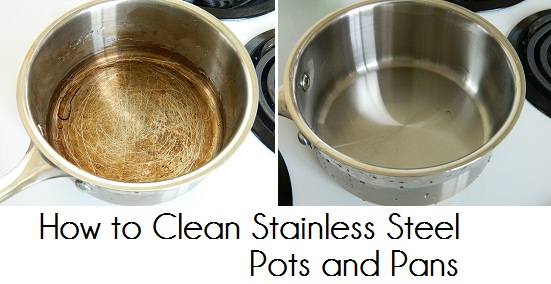

What are those numbers on the bottom of your pots and pans? If your pot is rusting or if there are signs that the core is wearing through, it is time to replace the pot because it’s probably leaching those metals into your food. The aluminum or copper core becomes an issue ONLY if the pot is scratched, grooved, or worn to expose it. Stainless steel does not conduct heat well, so cookware is usually made with an aluminum or copper core: essentially, a sheet of aluminum or copper sandwiched between layers of stainless steel to improve the pot’s heating ability. The combination of metals determines the grade of the stainless steel. Other metals can include nickel, manganese, aluminum, silicon, and sulfur. It always contains at least 10% chromium. Stainless steel is a low carbon, iron-based steel with other metals mixed in to reduce corrosion and increase strength.
:max_bytes(150000):strip_icc()/cleaning-burnt-stainless-steel-pots-pans-1707135_05_BakingSoda-e742fcad2e1e473ab42bf582b4545502.jpg)
#Cleaning stainless steel pans how to
Best Tools To Use When Cleaning Stainless Pots & Pansīefore we talk about how to clean stainless steel cookware, let’s learn about how non-toxic and safe it really is.#3 - Iridescent, rainbow-looking spots?.#2 - Don’t add cold food to a hot pan, if possible.#1 - Gently heat the pan before adding fat.How To Keep Food From Sticking To Non-Toxic Cookware.So, is stainless steel cookware really non-toxic and safe?.What are those numbers on the bottom of your pots and pans?.We test and review the best dish soap, microfiber cloths, and other cleaning tools. Quick tip: "Avoid blotting a club soda-soaked cloth or pouring club soda directly onto steel as it can be harder to completely dry without streaks," Bowen says.

Rinse with warm water if needed, and dry completely. Then rub in the direction of the grain with a microfiber cloth. To use it, pour some club soda into a spray bottle and apply it to the appliance or cookware. Finally apply a small amount of olive oil to a third soft cloth and wipe the appliances one last time to gently seal the grain.Īfter you've cleaned using dish soap or vinegar, give the stainless steel some extra shine using club soda.īowen says that club soda is "best for polishing already clean stainless steel to add sparkle and shine." Rinse out the soapy cloth and wipe the stainless steel again to remove any remaining soap. "This removes the acidic residue that vinegar leaves behind to ensure it doesn't interact poorly with the metal over time," Peterson says. Wet a second cloth with water and apply a few drops of dish soap. Exercise a gentle touch here - there's no need to scrub too hard because vinegar should effortlessly cut through the grease. Wipe everything down with a soft microfiber cloth, making sure to follow the direction of the grain. Shake the bottle well and spray the mixture on the stainless steel surfaces you want to clean. If you want to make the vinegar solution smell better, Peterson recommends adding a few drops of lemon juice. "Vinegar is all-natural, non-abrasive, and acts as an effective sanitizer," she says.įirst fill a spray bottle with equal parts water and white vinegar. If you have oily fingerprints and food grime on stainless-steel appliances and fixtures (regardless of size), Peterson recommends using vinegar to remove both. Peterson stresses you don't need a lot of oil to create a nice shine. Dip the microfiber in a small amount of mineral, coconut, or olive oil, and apply to the stainless steel to brighten the shine. Then spray the solution on the stainless steel, and wipe the mixture off (in the direction of the grain) with a microfiber cloth. Peterson recommends cleaning other types of stainless steel by mixing warm water and a few drops of dish soap in a small spray bottle. You also need to clean stainless-steel faucets and other types of fixtures. Your larger appliances won't fit in a sink and shouldn't be submerged in water. Then wipe down the surfaces with a microfiber cloth, making sure to wipe in the direction of the metal grain to avoid scratches or damage. Soak the stainless steel in soapy water for at least five minutes. "This method is quick, simple, and best for grimy stainless-steel cookware," Bowen says, explaining that this is especially good for stainless steel that needs degreasing or has a lot of food residue.īegin by filling the sink with warm water and adding a squirt of dish soap. If the stainless-steel appliance you're cleaning is too large to get soaked, use a spray bottle to apply the dish soap and warm water instead.īoth Peterson and Bowen recommend the use of dish soap as the best way to clean stainless-steel appliances and cookware.


 0 kommentar(er)
0 kommentar(er)
